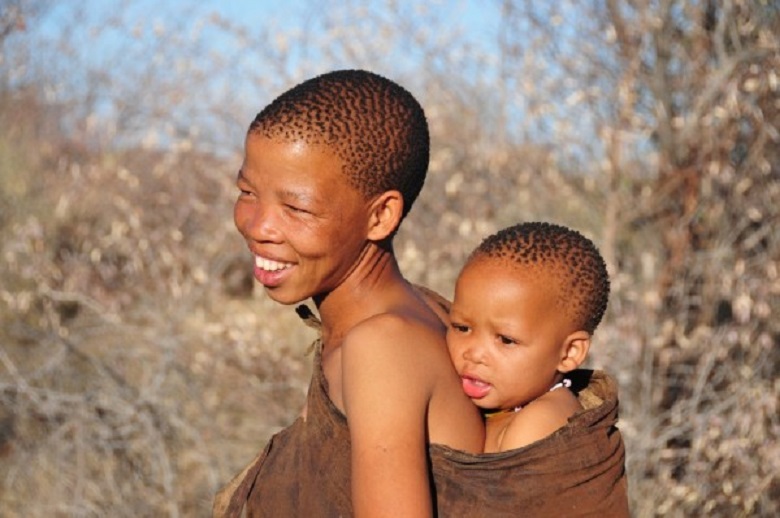The term “Khoisan” is used to designate two groups of peoples of southern Africa; the San, and the Khoi or Khoikhois. The two groups share distinct linguistic and physical characteristics of the Bantu, who are the majority in the region.
The San are popularly known as the “Bushmen,” and they are hunter-gatherers. The San form the indigenous population of southern Africa, the Khoïkhois having arrived a little later.

The Khoïkhoïs (designated Hottentots by the Afrikaner settlers who spoke Dutch) are generally pastoralists (herders), but over time, many have abandoned pastoralism to become hunter-gatherers and therefore considered San.
The San are the indigenous peoples of southern Africa before the Bantu arrives from North and East Africa, displacing the indigenous population. Researchers and historians cannot conclusively determine whether the Khoïkhois and the San have different origins. About 22,000 years ago, the Khoisans were the largest humans on Earth; they are estimated at around 100,000 today.
The Khoisan people are indigenous people of hunter-gatherers in southern Africa with ancient roots. Khoisan is one of the 14 population groups that constitute the origin of “modern” humans, and Khoisan tools have been found dating back to 44,000 BC. They are distributed among Botswana, Namibia, Angola, Zambia, Zimbabwe, and South Africa.
The San, also known in English as “Bushmen”, are directly descended from the original population of the first human ancestors who gave birth to all other groups of Africans and, finally, to people who left the continent to populate other parts of the world.
The Khoisan
A large study on African genetic diversity completed in 2009 found that the San were among the five populations with the highest genetic diversity levels measured among the 121 distinct African populations sampled.
The San are one of the 14 known “ancestral population groups” from which all modern humans descend. A genetic map of Africa – the continent from which all modern humans originate – has provided information on its great diversity of language and culture. It is the result of the most extensive African genetic study ever undertaken.
The study, published in the journal Science, took ten years of research involving trips to some of Africa’s most remote areas to collect blood samples. The project found that modern Africans have the most diverse DNA of any racial group globally, confirming the idea that Africa is the cradle of humanity, said Sarah Tishkoff of the University of Pennsylvania.
The team, led by Sarah Tishkoff of the University of Pennsylvania, studied genetic material from 121 African populations. Scientists have collected more than 3,000 samples and identified 14 “ancestral population groups”. These are groups of populations with common genetic ancestry who share ethnicity and similarities in their culture and languages’ properties.
“This is a spectacular glimpse into the history of African populations and, therefore, the history of mankind,” said Muntaser Ibrahim, a researcher from the University of Khartoum, who also participated in the study.
The team examined individual ancestry or genetic similarities in their samples by comparing the frequencies of more than 1,000 DNA markers – sections of DNA code known to reveal a common genetic makeup.
The research has also helped locate the origin of modern human migration in western southern Africa near Namibia and Angola’s coastal border. This is based on the widely accepted theory that the highest level of genetic diversity is in the oldest population – the one who has spent the most time on earth.
Genetic
Scientists also found genetic “markers” in the DNA of present-day East African inhabitants living near the Red Sea, indicating that they belonged to the same ancestral group that had migrated from Africa to populate it.
West Africans speaking the Niger-Kordofanian language (the renamed name of the Niger-Congolese languages which constitute the most extensive of the African language families. The vast majority of the languages of sub-Saharan Africa belong to this family) share many genetic traits with African Americans, indicating that they were the ancestors of most of the slaves sent to the New World.
The Sangoan and the Khoisan
The Khoisan have features of resemblance to the remains of the skeletons of the Sangoan. The Sangoan occupied parts of southern Africa at the end of the Stone Age and are the Khoisan ancestors. The Sangoans were hunters, a trait passed down to the Khoisan. A few hundred years later, it was not until they began to domesticate sheep and cattle after adopting the cultures of the Bantu who migrated from East Africa.
Khoisan language groups are different in structure and vocabulary, although the groups are closely related, unlike Bantu languages such as Xhosa and Zulu, which are similar to each other. After migrating to southern Africa, the Xhosa and Zulu adopted the click consonants unique to Khoisan and lent them a few words.
